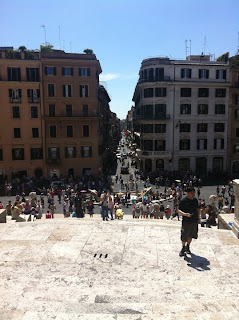The article "Italian Dress Code?" from YourGuidetoItaly.com provided a nice overview of what Italians typically wear, if you are looking to blend in with the locals. As a result of these tips, my packing consisted mostly of dresses, skirts, tops, and two pairs of jeans. I brought shorts, but only wore them to class or during the day. In regards to footwear, I packed Sperrys, some sandals, and a pair of wedges. Lots of walking, combined with cobblestone meant that I usually wore my Sperrys or Reef flip flops - the more comfortable footwear options. Packing a sweater is also important - many Italian churches require women to cover their knees and shoulders before entering!
A view of the Via Condotti, the Rodeo Drive of Italy.*
On our first day of classes in Rome, we had an Italian culture class, in which we discussed proper verbal and nonverbal communication, as well as the unspoken dress code. If you are striving to blend in with the locals, no shorts in the evening, and athletic wear is only worn when exercising. Additionally, Dr. Scholl and Birkenstock sandals (in fun colors or metallics, of course), as well as all white outfits are some of the local trends. I strongly recommend rocking an all-white or mostly white outfit at least ONCE when visiting Italy!
Looking put together at all times is important in maintaining the Italian ideal of la bella figura.
Shopping in Italy was also quite the experience. Aside from large stores, most vendors, whether it be food, souvenirs, or small businesses, only accept cash. A lot of commerce takes place outside in markets, although in Rome (and most major cities), there is at least one galleria, or shopping mall.

Popular stores range from global chains such as H&M, Benetton, and Zara to Italian/European brands such as Massimo Dutti, Oysho, Class, Oviesse, and Intimissimi. For fashion lovers, one perk of visiting Italy in the summer is that June and July are the time for MAJOR sales. Discounts usually start between 25 & 50 percent off!
Although the dollar to Euro conversion is still in Europe's favor, there are some perks to be aware of when shopping in Italy. VAT tax means that you pay sticker price for all items - tax is already added into the value! Additionally, if non-European Union citizens purchase luxury items upwards of 150 euros (this amount usually varies by country), they are elegible for a VAT tax refund. Rick Steves' website provides great info on VAT tax refunds.
(Top left photo: galleria in the heart of Rome*)
Even with a stronger Euro, sometimes it is more economical to purchase luxury items in Europe than in the U.S. due to import taxes. For example, items at global stores such as Zara, Benetton, and H&M don't pay import tax in the European Union, and will be less expensive in Italy. Additionally, I found that it is possible to save at least $50 on Longchamp totes when purchasing in Europe due to no import tax!
A child size Vespa in an Italian toy store!*
Since travel to Europe is pricey, it is important to be economical in purchasing and packing - hopefully these tips will be helpful when planning a trip to the boot!
*All photos are my own


No comments:
Post a Comment